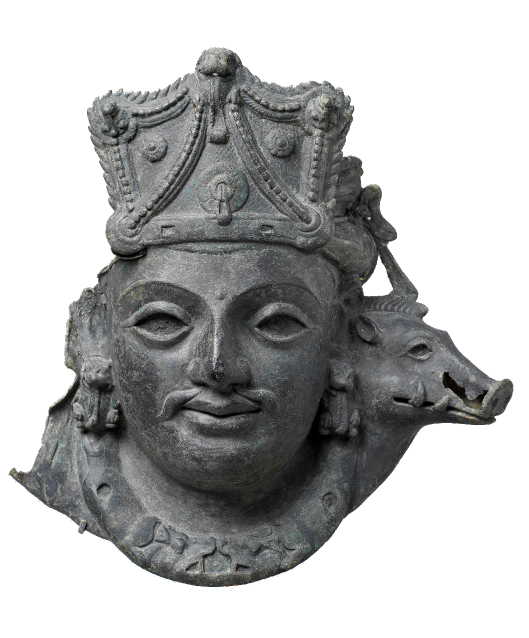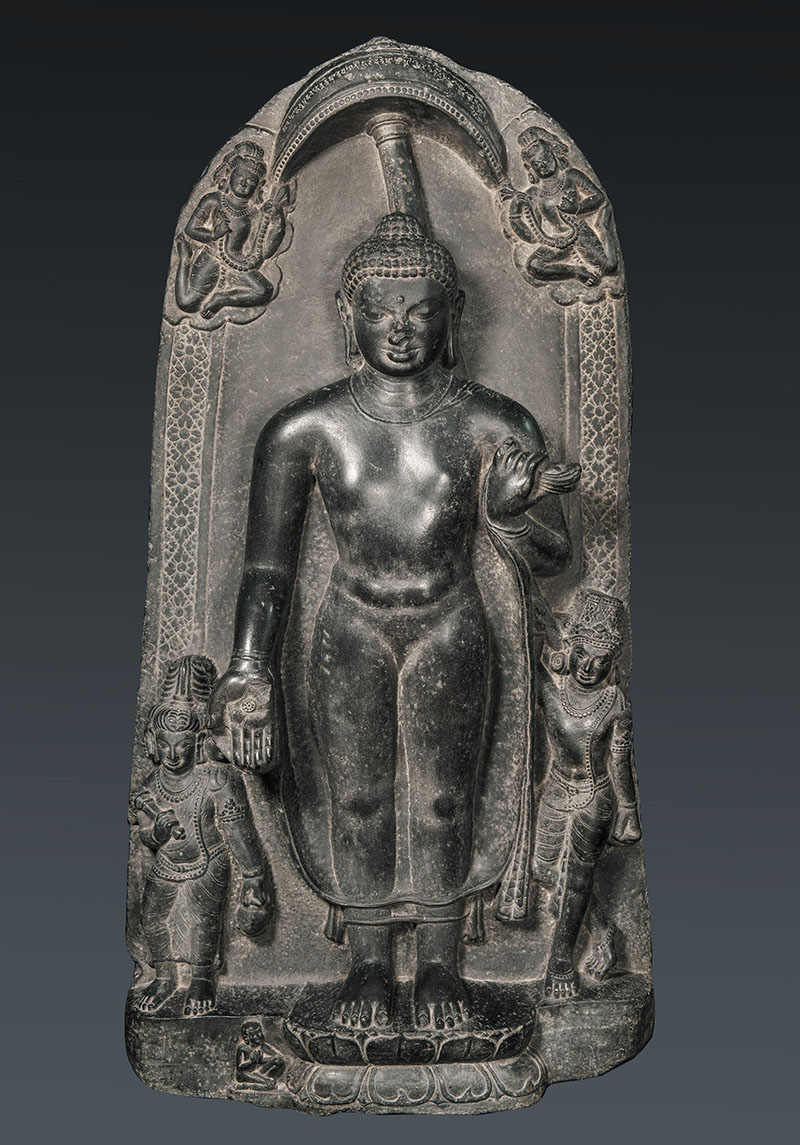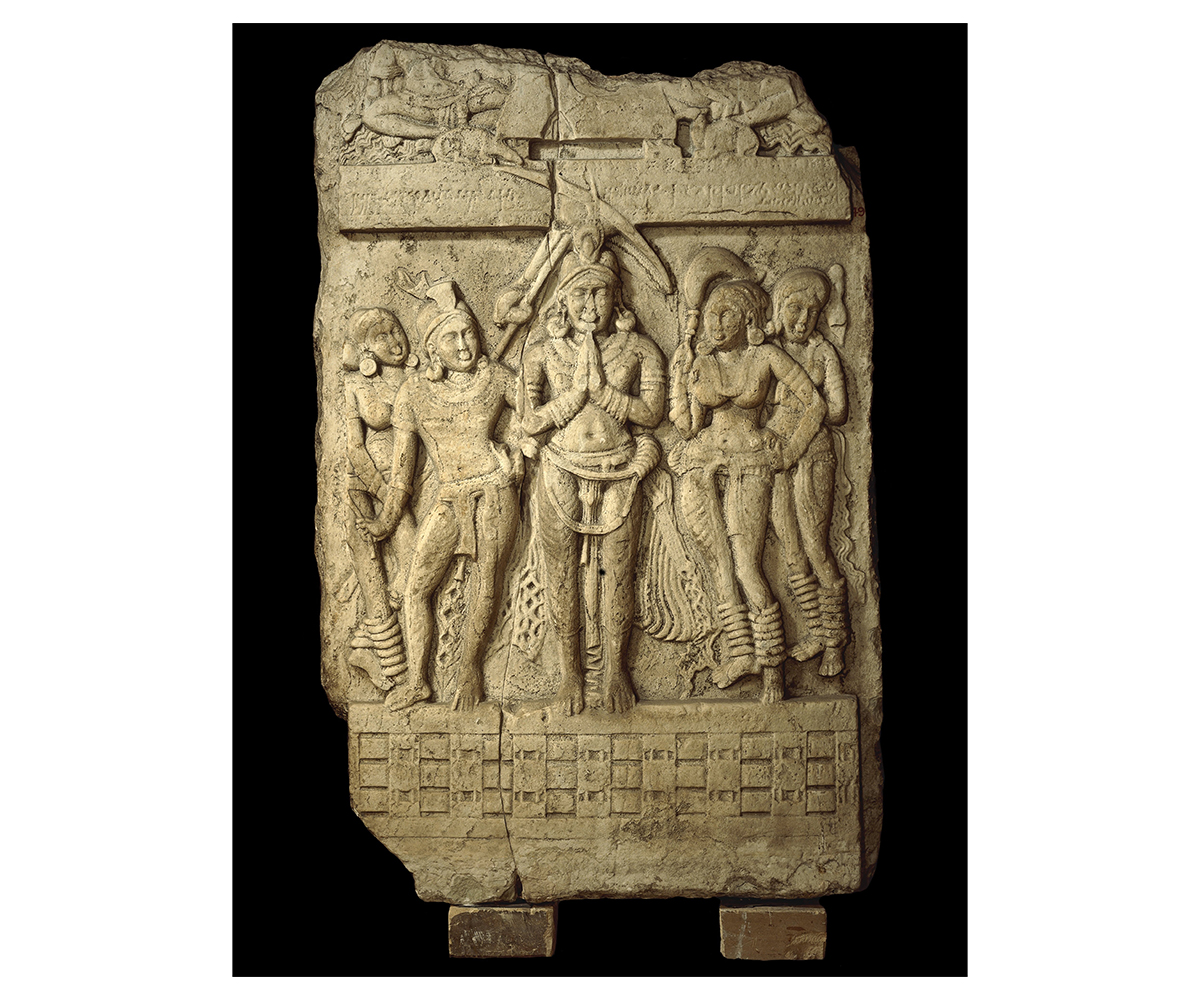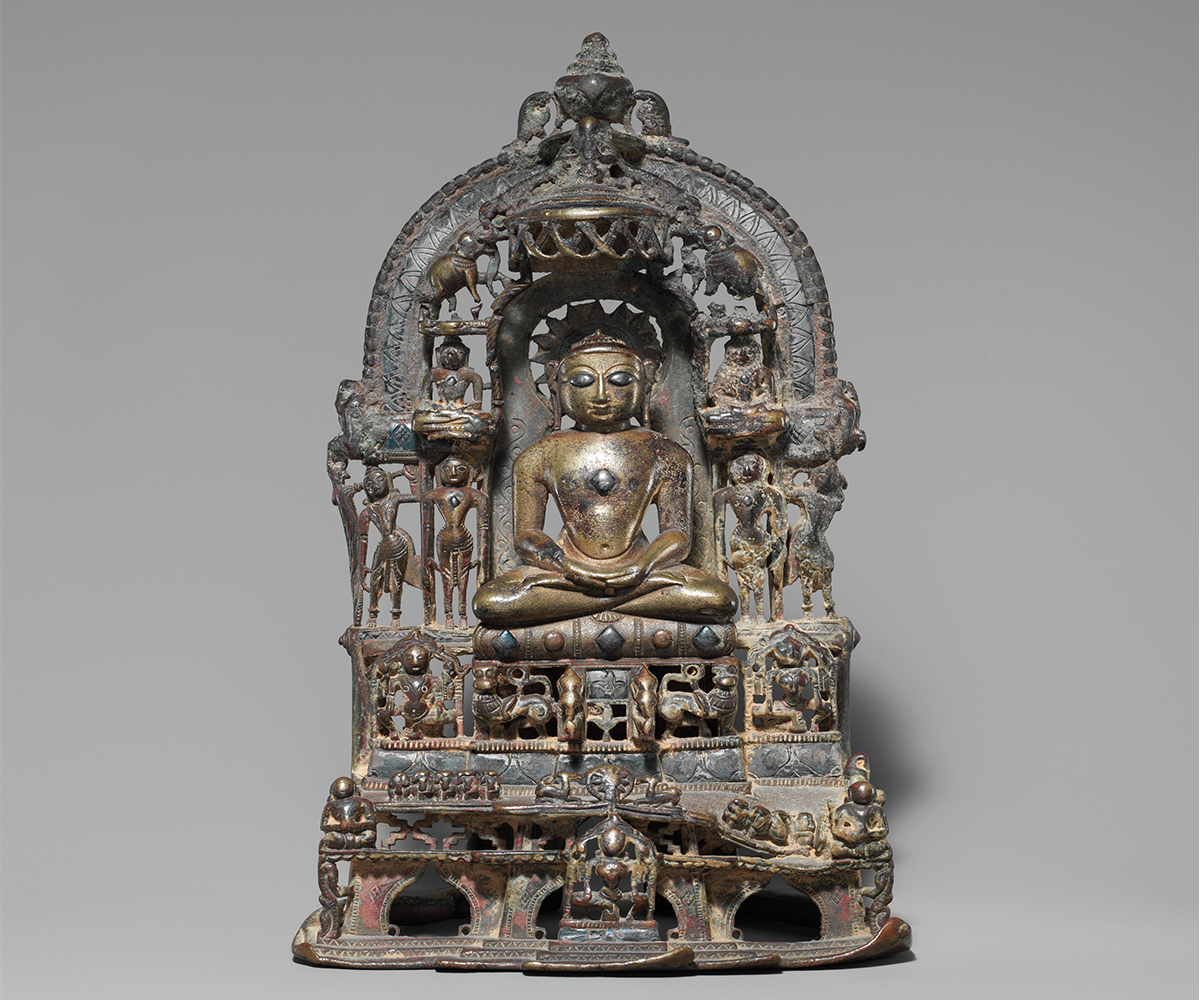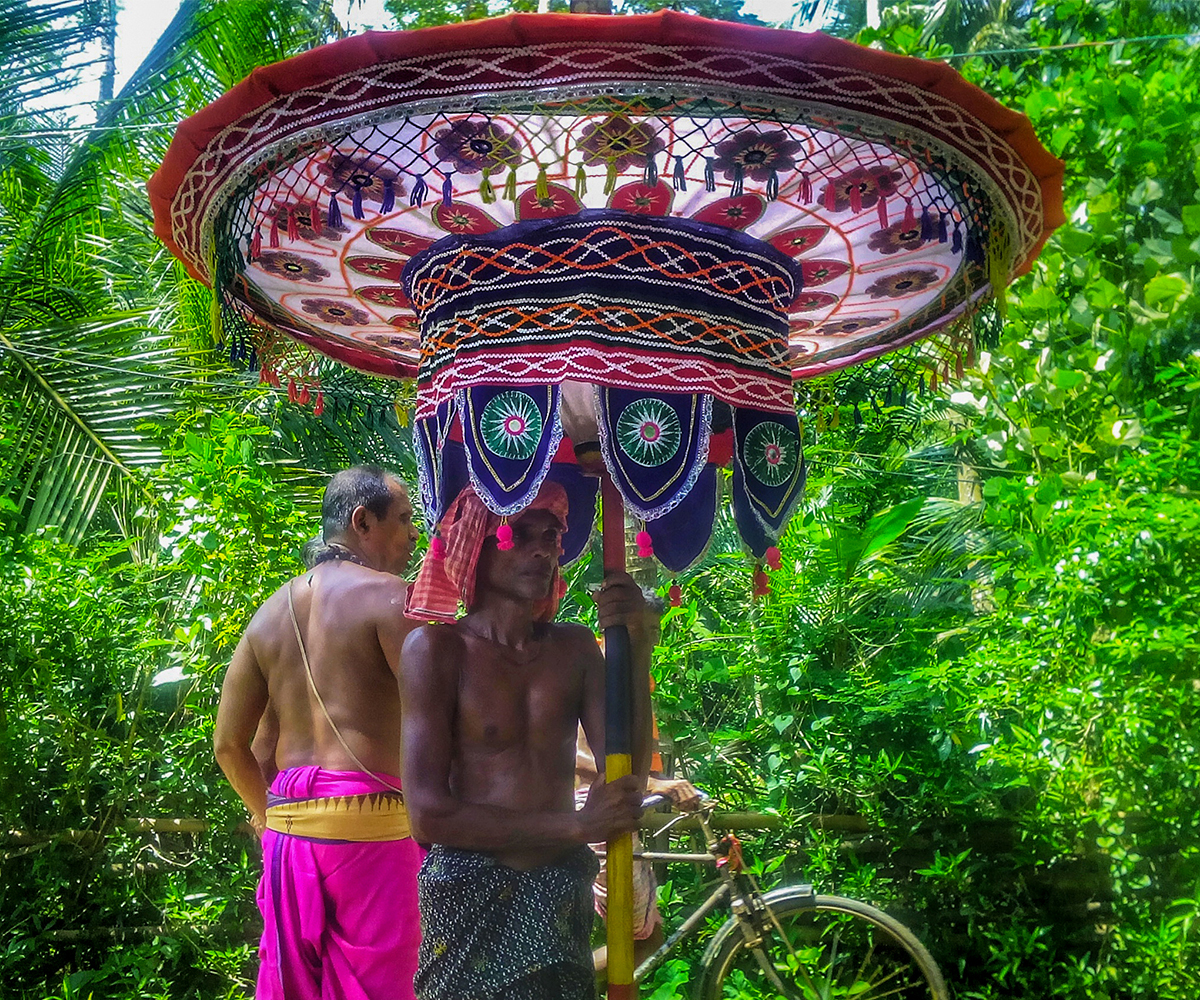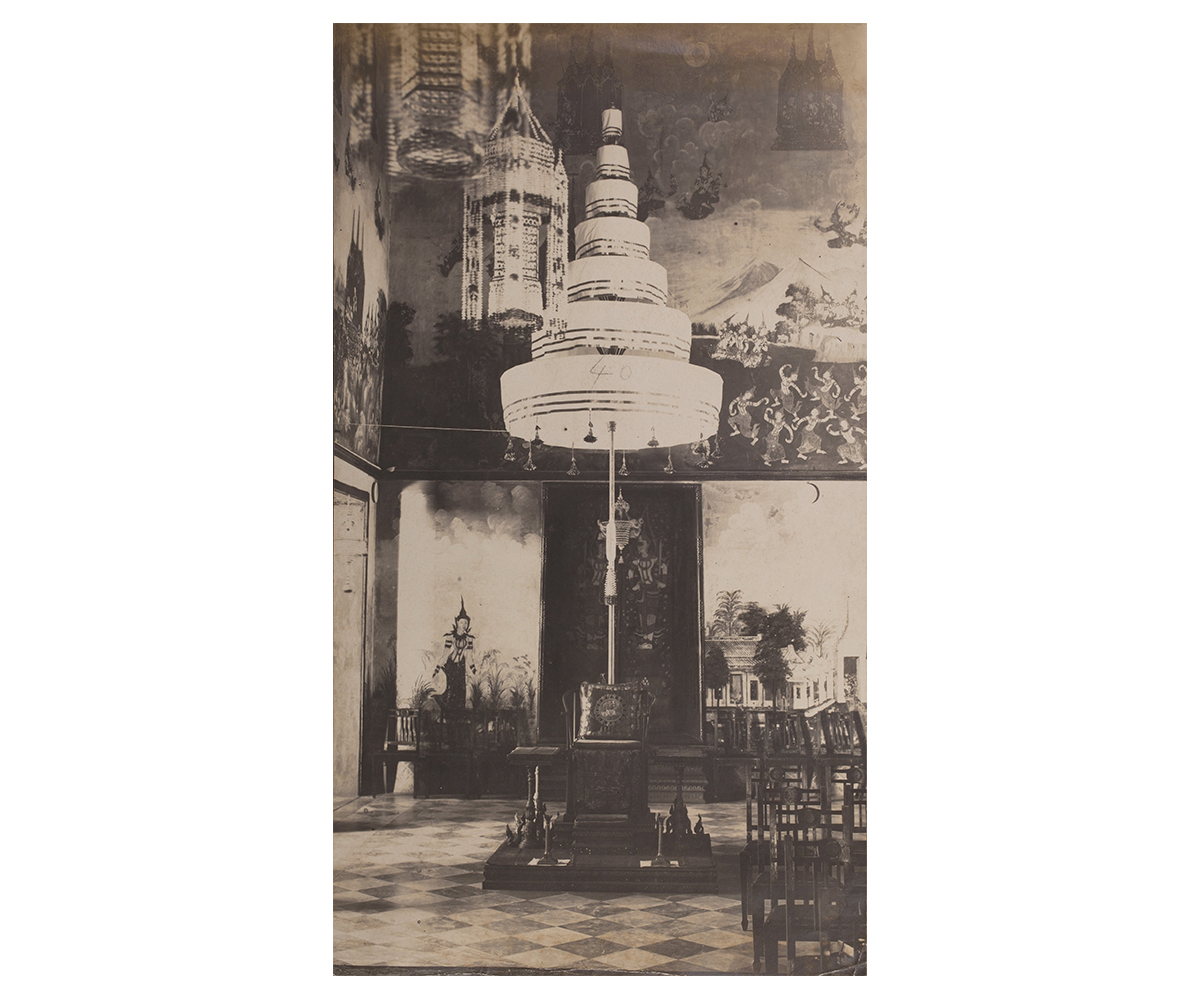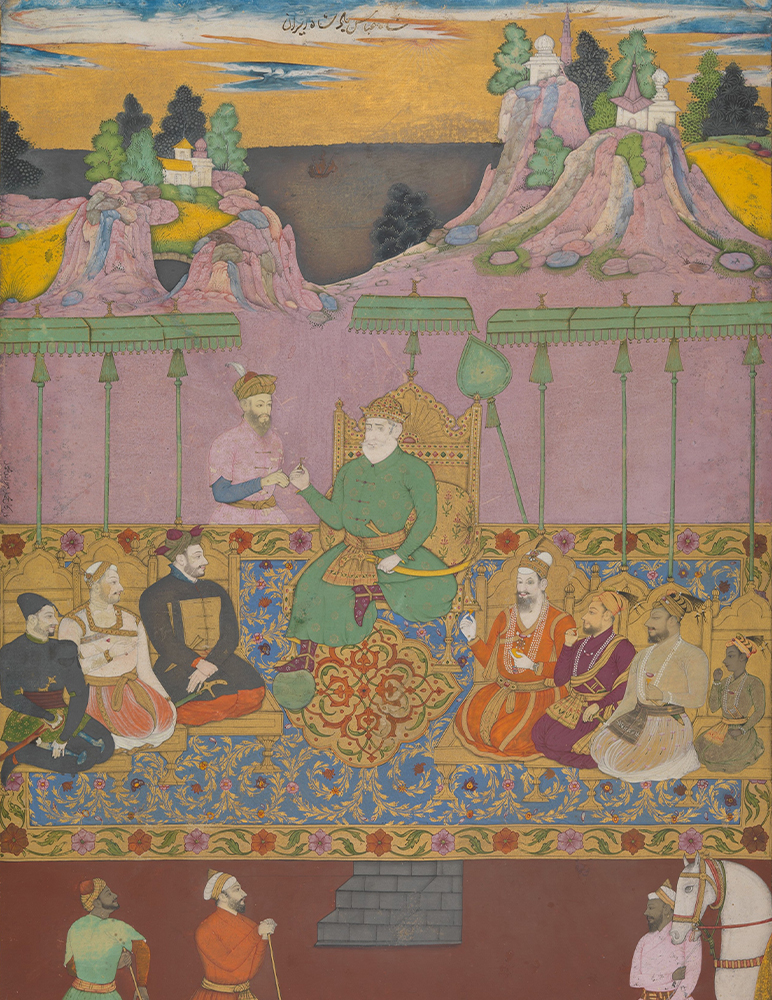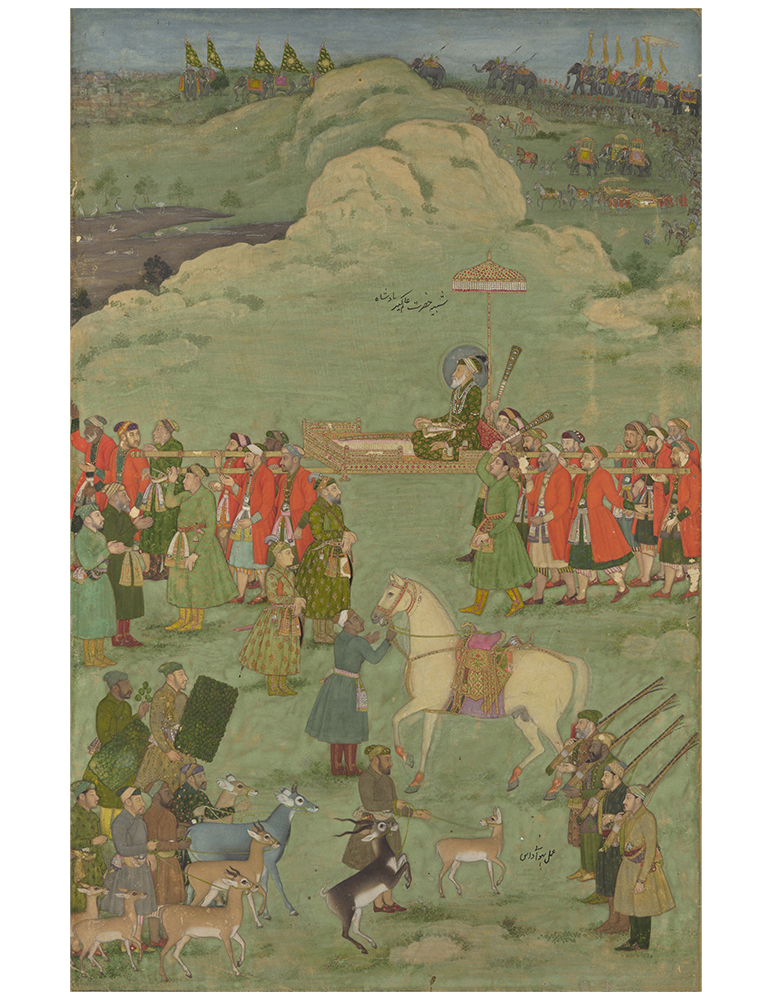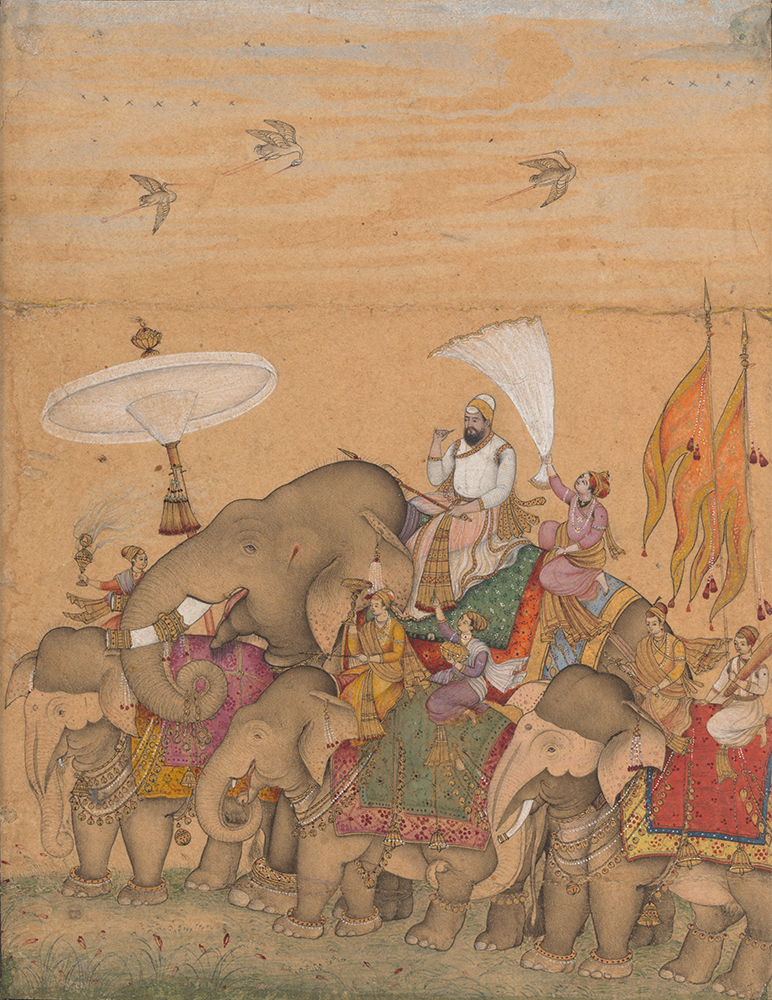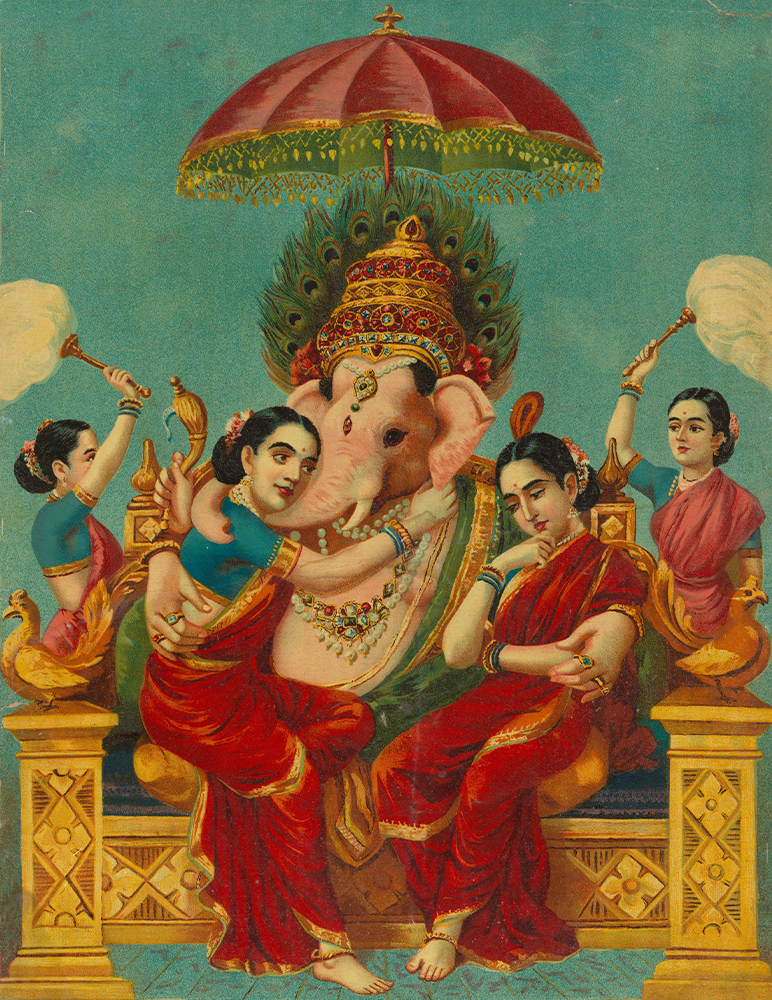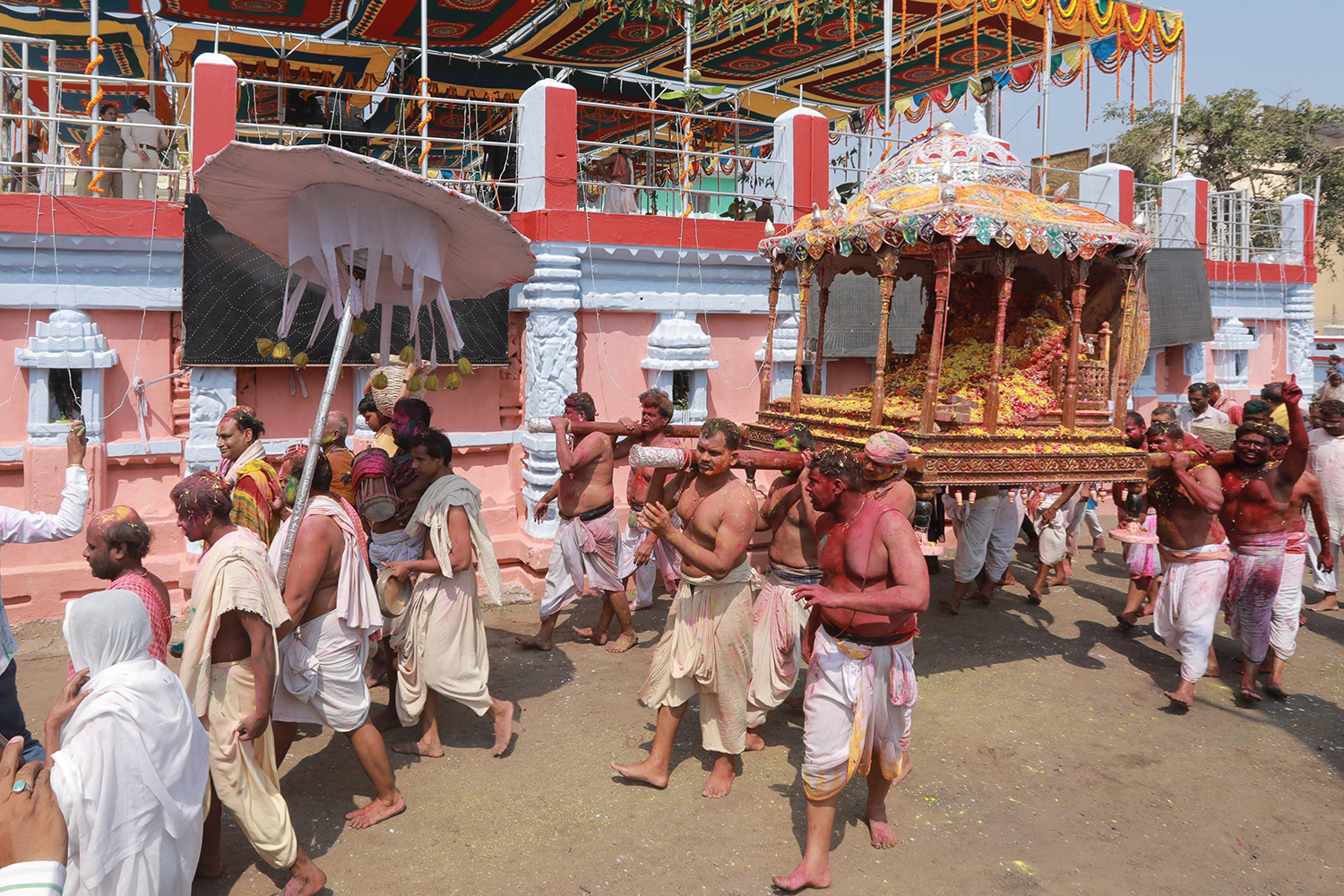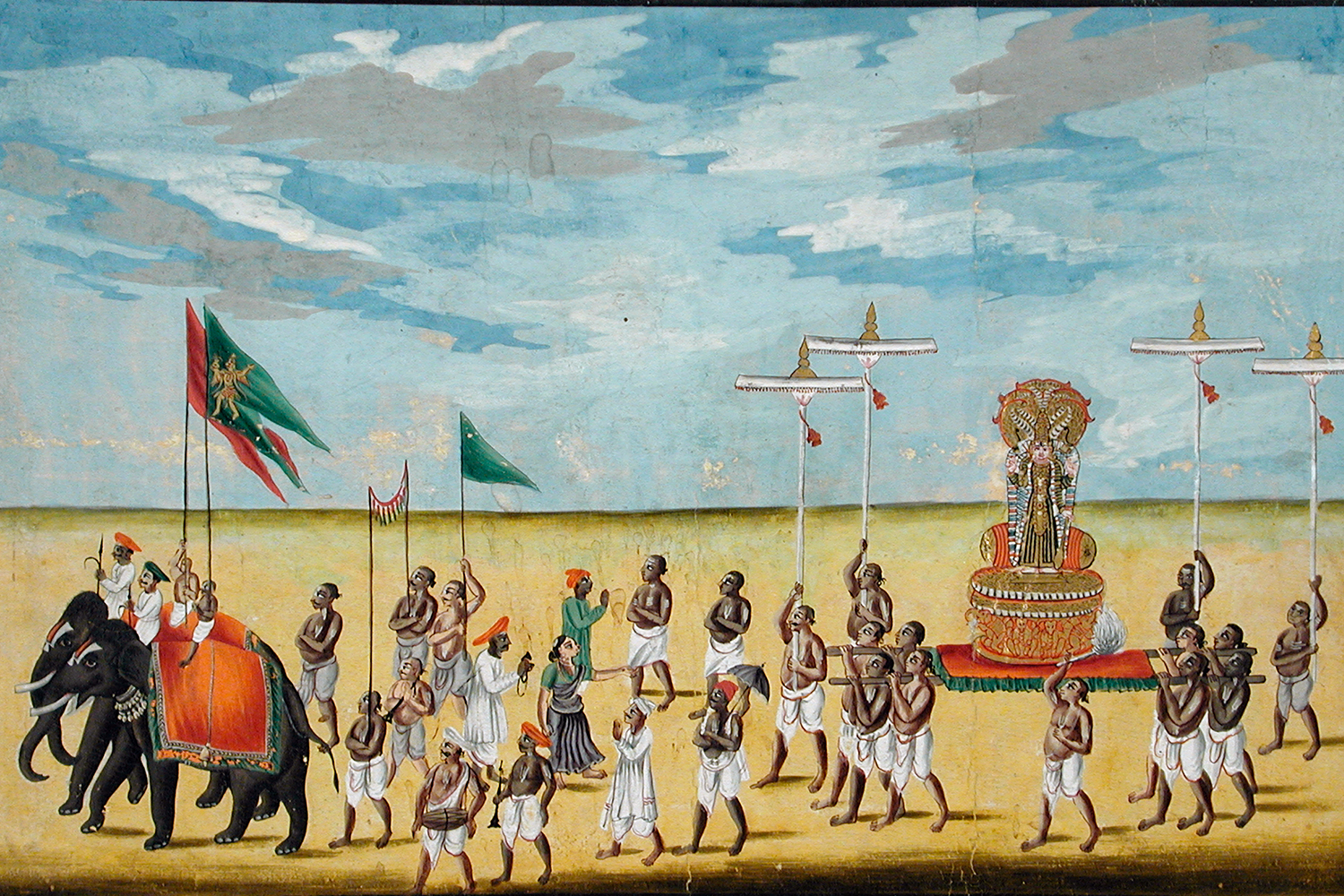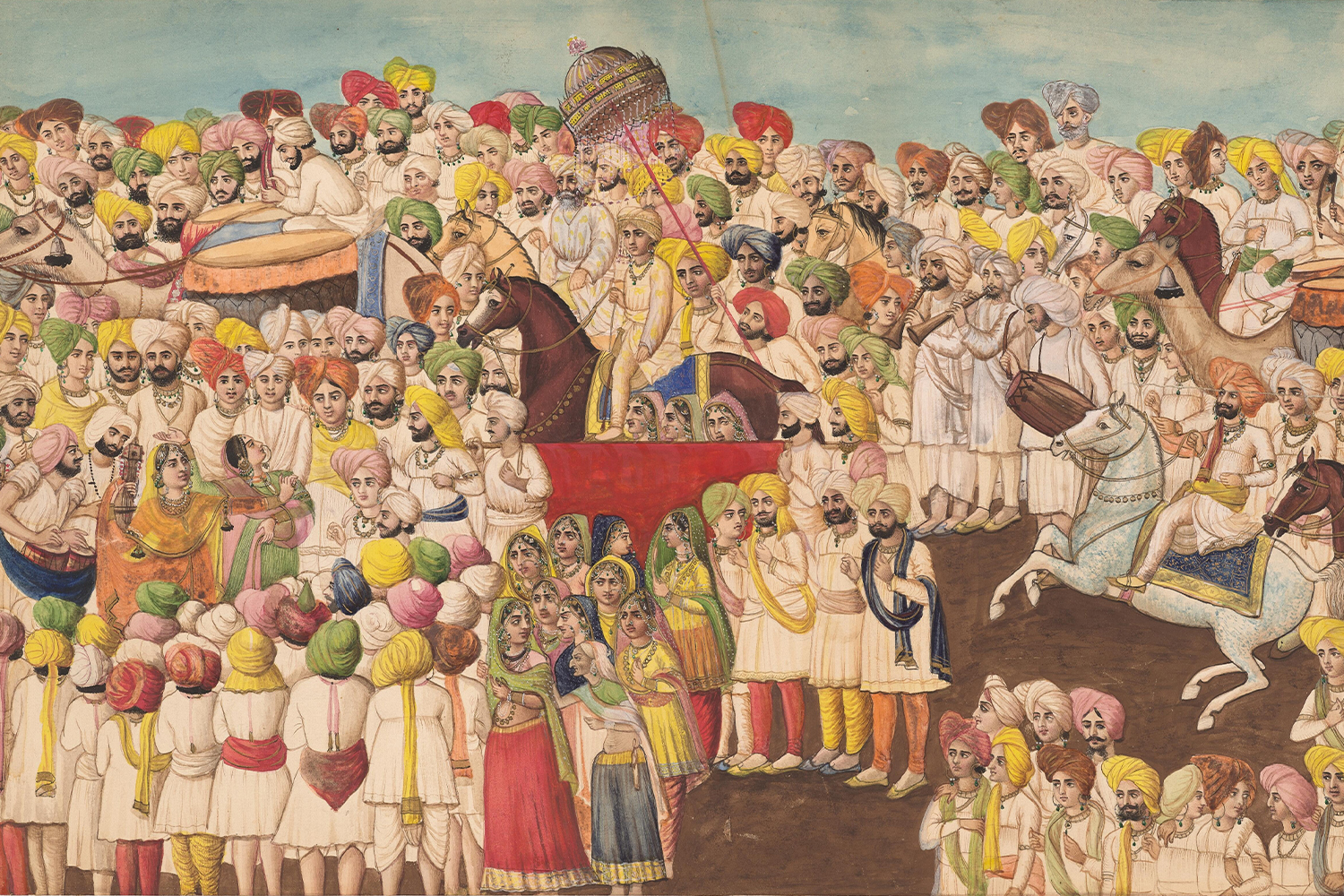ARTICLE
Ceremonial Parasol
After the introduction of the anthropomorphic Buddha in the first century AD, the figure is often shown to be sheltered by a wide parasol. A remarkable free-standing example is the Bala Buddha at Mathura dated to 130 CE; immediately behind the Buddha is a tall, narrow shaft that would have held the large, intricately carved stone parasol disk which is now displayed separately. In scholarly interpretations of historical images, a figure shown holding their own parasol is taken to be an ordinary person, whereas the parasol held by an aide or a fixed pole suggests the shaded figure’s political or religious importance.
Since at least the ninth century CE, statues of Jain Tirthankaras have often featured a conical three-tier parasol, known as chhatra in northern and western India, and mukkudai in southern India. It is shown floating above the tirthankara’s head, and is typically not carried by an attendant or held by any visible means, as seen in the monumental statue of Shantinatha in Temple 12 at Deogarh, Uttar Pradesh.
In Central and West Asia, the ancestral homelands of the Indian subcontinent’s Islamic dynasties, ceremonial parasols were used by royalty since antiquity; one of the earliest depictions of a royal parasol in the region is a stele from Mesopotamia dated to the second millennium BCE which shows the king Sargon of Akkad (r. 2234–79 BCE) shaded by a parasol held by an attendant. After their arrival in the Indian subcontinent, Islamic rulers adopted local habits of making and using parasols.
Parasols feature prominently in Indian painting traditions, including murals in the fourth-century CE Ajanta caves and the eleventh-century Brihadishvara Temple. The oldest surviving manuscript illustrations of parasols are found in palm leaf copies of the Ashtasahasrika Prajnaparamita made in eastern India and Nepal from the eleventh century onwards. Illustrated Jain paper manuscripts of the Kalpasutra and Kalacharyakatha, produced from the fifteenth century onwards, feature kings with flat-topped, tasselled parasols above their heads (notably distinct from the sacred three-tiered ones reserved for Tirthankaras). Flat-topped parasols also appear in Deccan paintings, manuscripts and muraqqas or albums, such as House of Bijapur (c. 1680) by Kamal and Chand Muhammad, which shows an assembly of the nine Adil Shahi sultans, all but one shaded by parasols. Small, purely ceremonial ones — used even under a canopy — are seen in paintings such as Aurangzeb holds court (c. 1660), possibly by Bichitr. The parasol was less prominent in illustrated Rajput manuscripts where it was rendered with simplicity and less often than in other traditions.
At many Hindu temples, cloth parasols are made for processions and other ceremonies, with larger, well-funded temples often commissioning numerous elaborate, technically complex parasols from artisans for these occasions. This has led to a number of distinctive craft traditions.
At the Jagannath Temple in Puri, Odisha, applique artisans from nearby Pipili have made ceremonial parasols — chhati in Odia — since the twelfth or thirteenth century. Appointed by the medieval kings of Puri, these artisans come from the Darji caste — tailors who form one subset of the larger group of the temple’s sebakas, or ‘those who serve (the deity)’. Chhatis feature at important temple events in which the idol is brought out of the garbhagriha, or sanctum, such as the ratha yatra or temple chariot procession. The flat top of the chhati is double layered, with a tasselled rim — while the outer cloth is relatively unembellished, the visible underside features detailed applique and embroidery work in concentric patterns. A cylinder of similarly decorated cloth hangs down from this inner layer, covering the top section of the parasol’s mast and ending in a deep zigzag edge with tassels at the pointed tips. This is embroidered in distinct horizontal bands featuring both abstract and figurative motifs. The circular base cloth was made of sturdy handspun cotton or khadi before mill cotton became commonplace; similarly, velvet was once the fabric of choice for the applique pieces, but has now largely been replaced by cheaper alternatives. The patterns are bold and colourful — common colours include red, black, green and yellow — and typically feature lighter colours on a dark background, with the applique pieces held down by the bakhia stitch (a type of back stitch) or the invisible taropa hemming stitch. The appliqued and embroidered motifs include various flora and fauna, interspersed with flat geometric shapes.
In Thanjavur, Tamil Nadu, kodai are among the craft goods made using the Kalamkari (painted cloth) technique, usually on commission from temples and other religious institutions. Brightly coloured, tasselled parasols are made in Madurai, Tamil Nadu, using an applique method similar to that practised at Puri and Pipili. During the annual Pooram festival in Kerala, the Vadakkunnathan Temple in Thrissur hosts a competition between the Krishna temple at Thiruvambadi and the Devi temple at Paramekkavu, both of which commission craftsmen to make several kodas — along with other ceremonial objects such as peacock feather fans, yak wool fly-whisks and jewellery, all displayed by participants on the backs of elephants. Forming the centrepiece of the display, these kodas feature embroidery, gold or silver borders and metallic tassels; they have become more elaborate in recent years, with multi-tiered, structurally complex designs often derived from Theyyam masks. A variation known as muthukuda features in processions held at church grounds on saints’ days in vernacular Christian traditions in Kerala.
In Sri Lanka, the ceremonial parasol — known in Sinhala as sesath — is made by dyeing, knotting and weaving the leaves of the Talipot palm tree into a flat circular form. Unlike other parasols, the disc is supported by a pole that runs parallel rather than perpendicular to it, and so the sesath can also double as a ceremonial fan. Historically made for royalty, the sesath was adopted as part of the ceremonial accessories of the Lascarins, a unit of Sri Lankan soldiers originally employed by Portuguese commanders on the island. The sesath was sometimes also made of wood; a few such specimens are currently housed at the Jaffna Archaeological Museum.
Now little used, the Burmese cloth parasol is called hti, a term also applied to the conical finial that crowns pagodas. It was typically made of cotton, with regional variations ranging from the tiered variety meant for royalty and other elites to the painted variety from Pathein, which has a similar form as contemporary umbrellas. Its use was regulated by strict rules in the country’s pre-colonial history, with the number of tiers varying according to the rank and royal favour accorded to each person. The nine-tiered white umbrella was reserved exclusively for use by the king, queen and statues of the Buddha, and a golden version was used by ministers, nobility and other members of the ruling class. Due to political changes, the craft of making these elaborate, tiered hti is now moribund. The simpler Pathein parasol is translucent, waterproof and meant for practical everyday use by Buddhist monks.
Bibliography
Bruhn, Klaus. “The Jaina Art of Gwalior and Deogarh.” In Jainism: A Pictorial Guide to the Religion of Non-Violence, edited by Kurt Titze (New Delhi: Motilal Banarsidass Publishers, 1998), 101-18.
Burgess, James. The Buddhist Stupas of Amaravati and Jaggayyapeta in the Krishna District, Madras Presidency, Surveyed in 1882. 1886. Reprint, New Delhi: Archaeological Survey of India, 1996.
Crill, Rosemary. “Textiles and Architecture in India.” V&A Blog. December 04, 2015. Accessed April 23, 2024. https://www.vam.ac.uk/blog/fabric-of-india/textiles-and-architecture-in-india.
Haidar, Navina Najat, and Marika Sardar. Sultans of Deccan India, 1500-1700: Opulence and Fantasy. New York: Metropolitan Museum of Art, 2015.
Huntington, Susan L, and John C. Huntington. The Art of Ancient India: Buddhist, Hindu, Jain. New York, Tokyo: Weather Hill, 1985.
Ghose, Ruchira. Mapping Indian Textiles: Approaches to Display and Storage of Indian Textiles in Public Museums. New Delhi: Indira Gandhi National Centre for the Arts, 2017.
Kannan, R., Lakshminarayanan, K. Iconography of the Jain Images in the Government Museum, Chennai, Madras. Chennai: Commissioner of Museums, Government Museum, 2001.
McInerney, Terence. Divine Pleasures: Painting from India’s Rajput Courts. New York: Metropolitan Museum of Art, 2016.
Mills, Margaret Ann, Peter J. Claus, and Sarah Diamond. South Asian Folklore: An Encyclopedia: Afghanistan, Bangladesh, India, Nepal, Pakistan, Sri Lanka. Abingdon, UK; New York: Routledge, 2003.
Naik, Shailaja D. Traditional Embroideries of India. New Delhi: APH Publishing Corporation, 1996.
Pal, Pratapaditya, and Julia Meech-Pekarik. Buddhist Book Illuminations. Hyderabad: Ravi Kumar Publishers, 1988.
Perera, Sasanka. Warzone Tourism in Sri Lanka: Tales from Darker Places in Paradise. New Delhi: SAGE Publications, 2016.
Quintanilla, Sonya Rhie. History of Early Stone Sculpture at Mathura, ca. 150 BCE – 100 CE. Leiden and Boston: Brill, 2007.
Ranjan, Aditi, and M. P. Ranjan. Handmade in India: Crafts of India. Ahmedabad: Mapin, 2007.
Scott, James George. The Burman, His Life and Notions. London: Macmillan, 1910.
Seekins, Donald M. Historical Dictionary of Burma (Myanmar), Historical Dictionaries of Asia, Oceania, and the Middle East, No. 59. Maryland, USA: Scarecrow Press, 2006.
